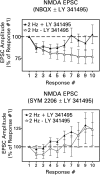Short-term frequency-dependent plasticity at recurrent mossy fiber synapses of the epileptic brain
- PMID: 12832564
- PMCID: PMC6741152
- DOI: 10.1523/JNEUROSCI.23-12-05381.2003
Short-term frequency-dependent plasticity at recurrent mossy fiber synapses of the epileptic brain
Abstract
The recurrent mossy fiber pathway of the dentate gyrus expands dramatically in human temporal lobe epilepsy and in animal models of this disorder, creating monosynaptic connections among granule cells. This novel granule cell network can support reverberating excitation but is difficult to activate with low-frequency stimulation. This study used hippocampal slices from pilocarpine-treated rats to explore the dependence of synaptic transmission in this pathway on stimulus frequency. Minimal electrically evoked EPSCs exhibited a high failure rate ( approximately 60%). Stimulus trains delivered at a frequency of <1 Hz depressed synaptic transmission, as evidenced by an increase in response failures. Conversely, stimulus trains delivered at higher frequencies reduced the percentage of response failures and increased the amplitude of compound EPSCs, including pharmacologically isolated NMDA receptor-mediated EPSCs. Short-term frequency-dependent facilitation was of modest size compared with mossy fiber synapses on other neuronal types. Facilitation depended on the activation of kainate receptors by released glutamate and was inhibited by feedback activation of type II metabotropic glutamate receptors. These results suggest that the recurrent mossy fiber pathway may be functionally silent during baseline asynchronous granule cell activity in vivo attributable, in part, to progressive transmission failure. The pathway may synchronize granule cell firing and may promote seizure propagation most effectively during the brief periods of high-frequency granule cell firing that occur during normal behavior, during the periods of hypersynchronous fast activity characteristic of epileptic brain and, most importantly, during the period of increasing granule cell activity that precedes a spontaneous seizure.
Figures










Similar articles
-
The recurrent mossy fiber pathway of the epileptic brain.Neurochem Res. 2003 Nov;28(11):1649-58. doi: 10.1023/a:1026004904199. Neurochem Res. 2003. PMID: 14584819 Review.
-
Recurrent mossy fiber pathway in rat dentate gyrus: synaptic currents evoked in presence and absence of seizure-induced growth.J Neurophysiol. 1999 Apr;81(4):1645-60. doi: 10.1152/jn.1999.81.4.1645. J Neurophysiol. 1999. PMID: 10200201
-
Glutamate receptor involvement in dentate granule cell epileptiform activity evoked by mossy fiber stimulation.Brain Res. 2001 Oct 5;915(1):58-69. doi: 10.1016/s0006-8993(01)02824-4. Brain Res. 2001. PMID: 11578620
-
Spontaneous release of neuropeptide Y tonically inhibits recurrent mossy fiber synaptic transmission in epileptic brain.J Neurosci. 2005 Feb 16;25(7):1718-29. doi: 10.1523/JNEUROSCI.4835-04.2005. J Neurosci. 2005. PMID: 15716408 Free PMC article.
-
Neuropeptide Y in the recurrent mossy fiber pathway.Peptides. 2007 Feb;28(2):357-64. doi: 10.1016/j.peptides.2006.07.026. Epub 2007 Jan 3. Peptides. 2007. PMID: 17204350 Free PMC article. Review.
Cited by
-
The recurrent mossy fiber pathway of the epileptic brain.Neurochem Res. 2003 Nov;28(11):1649-58. doi: 10.1023/a:1026004904199. Neurochem Res. 2003. PMID: 14584819 Review.
-
Selective Medial Septum Lesions in Healthy Rats Induce Longitudinal Changes in Microstructure of Limbic Regions, Behavioral Alterations, and Increased Susceptibility to Status Epilepticus.Mol Neurobiol. 2024 Oct;61(10):1-21. doi: 10.1007/s12035-024-04069-9. Epub 2024 Mar 5. Mol Neurobiol. 2024. PMID: 38443731 Free PMC article.
-
An overview of brain-derived neurotrophic factor and implications for excitotoxic vulnerability in the hippocampus.Int J Pept. 2011;2011:654085. doi: 10.1155/2011/654085. Epub 2011 Sep 28. Int J Pept. 2011. PMID: 21966294 Free PMC article.
-
Studying network mechanisms using intracranial stimulation in epileptic patients.Front Syst Neurosci. 2010 Oct 20;4:148. doi: 10.3389/fnsys.2010.00148. eCollection 2010. Front Syst Neurosci. 2010. PMID: 21060722 Free PMC article.
-
Down-regulation of BK channel expression in the pilocarpine model of temporal lobe epilepsy.Brain Res. 2008 Mar 20;1200:116-31. doi: 10.1016/j.brainres.2008.01.017. Epub 2008 Jan 18. Brain Res. 2008. PMID: 18295190 Free PMC article.
References
-
- Babb TL, Kupfer WR, Pretorius JK, Crandall PH, Levesque MF ( 1991) Synaptic reorganization by mossy fibers in human epileptic fascia dentata. Neuroscience 42: 351–363. - PubMed
-
- Blanton MG, Lo Turco J, Kriegstein AR ( 1989) Whole-cell recording from neurons in slices of reptilian and mammalian cortex. J Neurosci Methods 30: 203–210. - PubMed
-
- Bragin A, Engel J, Wilson CL, Fried I, Mathern GW ( 1999) Hippocampal and entorhinal cortex high-frequency oscillations (100–500 Hz) in human epileptic brain and in kainic acid-treated rats with chronic seizures. Epilepsia 40: 127–137. - PubMed
Publication types
MeSH terms
Substances
Grants and funding
LinkOut - more resources
Full Text Sources
Other Literature Sources
Medical
